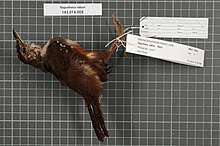Cordillera ground warbler
The Cordillera ground warbler, also known as Rabor's wren-babbler, and Luzon wren-babbler (Robsonius rabori) is a species of bird currently placed in the family Locustellidae. It is endemic to the Philippines. Some taxonomists continue to list the species in the Timaliidae, others in the Pellorneidae.
| Cordillera ground warbler | |
|---|---|
 | |
| Scientific classification | |
| Kingdom: | Animalia |
| Phylum: | Chordata |
| Class: | Aves |
| Order: | Passeriformes |
| Family: | Locustellidae |
| Genus: | Robsonius |
| Species: | R. rabori |
| Binomial name | |
| Robsonius rabori Rand, 1960 | |
| Synonyms | |
|
Napothera rabori | |
Its natural habitat is subtropical or tropical moist lowland forests. It is threatened by habitat loss.
Taxonomy
The Cordillera ground warbler was described by the Canadian zoologist Austin L. Rand in 1960 and given the binomial name Napothera rabori. The specific epithet was chosen to honour Dioscoro S. Rabor who had collected the type specimen on the Philippine island of Luzon.[2]
Ground warblers were first discovered in 1959 by an expedition team headed by Dioscoro S. Rabor. They conducted walking surveys of 2,000 meters each and recorded all of the bird calls they observed. There were initially two varieties discovered, now called the Cordillera ground warbler (Robsonius rabori) and the Bicol ground warbler (Robsonius sorsogonensis). The latter was first observed in 1961. The physical distinctions between them are mainly different coloration and geographic range. Originally, they had been classified as a member of the genus Nathopera because it was believed they were closely related to southeast Asian Napothera babblers. They were later lumped into the same species, but afterwards morphological evidence, behavioral observations, and the phylogeny of these birds led to their reclassification into a different genus, Robsonius, within the family Timaliidae. In 2013, a new species was discovered: the Sierra Madre ground warbler (Robsonius thompsoni). There are two other subspecies of the ground warbler: mesoluzonica and another from the Camarines Sur.
Description
The Cordillera ground warbler has a length of 20–22 cm (7.9–8.7 in). It has rather notable long legs and a long bill. Its feathers tipped dusky brown and it has a rusty-chestnut head with a thin whitish eye ring with a small area of bare gray skin behind the eye. Its throat is white and has black tips on the outside of it. The breast is a medium neutral gray, with feather shafts slightly paler and a white belly. It also has chestnut wings to dark brown wings with each feather tucked in so it appears mostly chestnut when folded. The bird sings very high-pitched songs which often last between approximately 1.6 and 2.2 seconds.
Distribution and habitat
The Cordillera ground warbler are found in the Luzon Island complex. They are found in the northern Luzon in the Cordillera Central and the northern Sierra Madre. Typically, they remain within low-land forest and secondary growth areas, between sea-level and 1300m.
Behaviour and ecology
Breeding
Very little is known about the Cordillera ground warblers breeding method. The nest are mostly found on rock cliffs, made up of wet sticks, branches, and leaves. The nest is a dome shape and has an entrance way in it. The dome is held up by twigs attached to the rock and mud that surrounds it.
Food and feeding
The diet of the Cordillera ground warbler is primarily invertebrates, it has been sighted scouring forest floors for prey hidden under leaves.
Conservation
This species is currently being protected within the Northern Sierra Madre Natural Park. Proposed efforts have been put forth to monitor the species further, and obtain information about how it can further be protected, however no other efforts are being used.
References
- BirdLife International (2017). "Robsonius rabori". IUCN Red List of Threatened Species. 2017: e.T103798817A119834785. doi:10.2305/IUCN.UK.2017-3.RLTS.T103798817A119834785.en. Retrieved 15 December 2017.
- Rand, Austin L. (1960). "A new species of babbling thrush from the Philippines". Fieldiana Zoology. 39 (33): 377–378.
- BirdLife International 2013. Robsonius rabori. 2013 IUCN Red List of Threatened Species. Downloaded on 1 January 2014.
- Collar, N. J. & Robson, C. 2007. Family Timaliidae (Babblers) pp. 70 – 291 in; del Hoyo, J., Elliott, A. & Christie, D.A. eds. Handbook of the Birds of the World, Vol. 12. Picathartes to Tits and Chickadees. Lynx Edicions, Barcelona.
- Hosner, Peter A., Nikki C. Boggess, Phillip Alviola, Luis A. Sánchez-González, Carl H. Oliveros, Rolly Urriza, and Robert G. Moyle. "Phylogeography of TheGround-Warblers (Passeriformes: Locustellidae) Reveals an Undescribed Species from Northeastern Luzon, Philippines." The Condor 115.3 (2013): 630–39.
- Sánchez-González, Luis A., et al. "Nests, Nest Placement, And Eggs Of Three Philippine Endemic Birds." Wilson Journal of Ornithology 122.3 (2010): 587–591. Academic Search Premier. Web. 23 October 2014.
